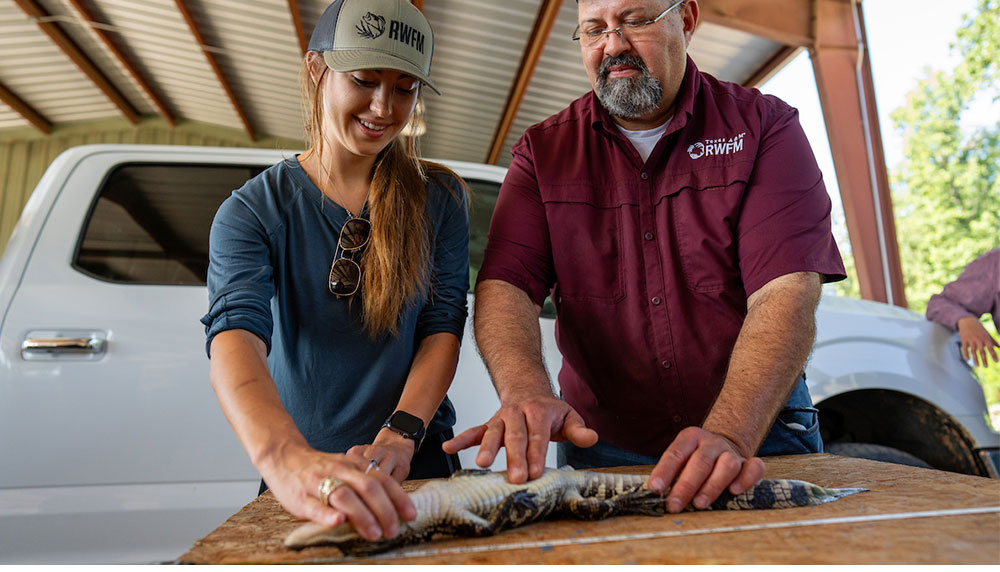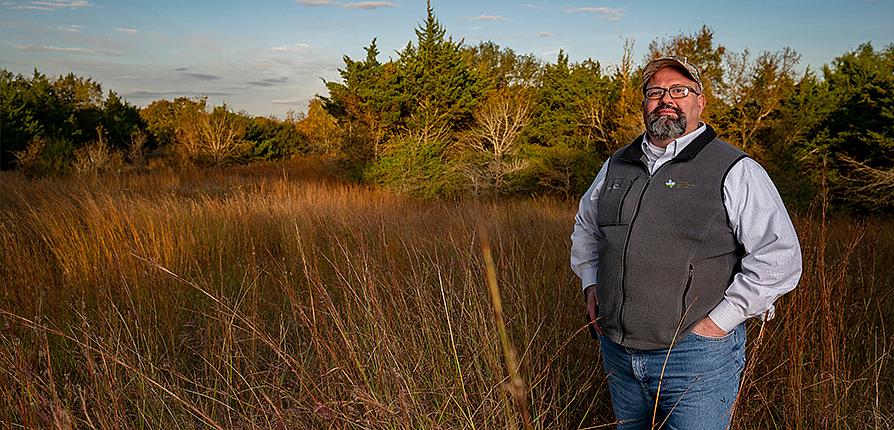Photo by Sam Craft '04 / Texas A&M AgriLife
A force in the natural resource conservation realm in Texas and beyond
Introduction By Christine Broussard '10 & '20
Dr. Roel Lopez '93, head of Texas A&M University's Department of Rangeland Wildlife and Fisheries Management and director of the university's Natural Resources Institute, is making a significant and lasting impact in the world of natural resource conservation.
After graduating from SFA with a Bachelor of Science in Forestry, Lopez went on to help write U.S. policy on military land sustainability for the Pentagon and study endangered species and the trends affecting farms and ranches in Texas and beyond. Lopez's efforts have led to meaningful recognitions, such as being named the Dallas Safari Club's Conservation Trailblazer.
He graciously sat down to share about how his time at SFA shaped both his research and his advocacy for a "learn by doing" style of teaching.
Q: What academic degrees have you received and from where?
A: Doctor of Philosophy, Texas A&M University, 2001
Master of Science, Texas A&M University, 1996
Bachelor of Science in Forestry, Stephen F. Austin State University, 1993
Q: Can you describe your initial inspiration for pursuing a career in wildlife conservation?
A: My involvement with the Boy Scouts of America and growing up hunting, fishing and spending time outdoors shaped my passion and interest in natural resources. These activities instilled in me a deep connection to the environment and inspired me to pursue a career in forest wildlife conservation. This allowed me to play a role in the stewardship of our precious natural resources.
Q: What were the most significant challenges you faced early in your career?
A: An accident that temporarily impacted my father (he was hit by a fire truck while voting; can't make it up!). This made it difficult for me to stay enrolled in school during his recovery. In approaching Danny Gallant, SFA's financial director at the time, for payment options, both Gallant and Betty Ford with the Alumni Association facilitated a small scholarship that allowed me to stay in school and complete my degree. Their unwavering support during that critical time was invaluable, and I am forever grateful for their assistance during a moment of need. I will never forget that small act of kindness and compassion.
Q: How did your SFA education influence your professional path?
A: The hands-on approach and extensive field experiences in the forestry undergraduate program shaped and prepared me for a career in natural resources. The classroom and field experiences were practical and mirrored what I could expect in the profession upon finishing my undergraduate program. The experience also developed my interest in graduate research, which began a lifelong focus in learning and improving how we manage our natural landscapes. In addition, the mentorship and guidance of faculty like Dr. Monty Whiting really instilled a sense of professionalism and the importance of hard work in achieving my career goals.
Q: What motivated you to focus on each of your areas of expertise?
A: My current area of expertise and research includes research and management of threatened and endangered species, military land sustainability, and understanding the trends and relationships to changes in farms and ranches in Texas and beyond.
More than 1,200 people move to Texas each day, which adds pressure on our private working lands (i.e., farms, ranches, family forests) and ultimately impacts our natural resources. These impacts include fragmented and degraded wildlife habitat, which oftentimes includes species that are threatened and/or endangered. These changes in rural lands also impact other areas important to our state's economy, like maintaining our military installations and ranges.
The contribution of the U.S. Department of Defense to the Texas economy is ranked second in the state (behind the oil and gas economy) — private working lands are great neighbors for these military installations. Nearly 15 years ago, I had the opportunity to go to Washington, D.C., to work in the Pentagon and, while there, gained a deep appreciation and interest in military land sustainability, which is basically protecting and maintaining open space both inside the fence line and in surrounding areas to offer our men and women in uniform the opportunity to test, train and ensure readiness prior to engagement during wartime activity.
Thus, providing suitable habitats for our wildlife as well as compatible land uses surrounding our military installations has largely been driven by my passion and interest in conserving Texas' private lands. The three areas of focus are all connected and complement and support one another.
Q: Can you share a memorable moment or breakthrough from your research career?
A: Working in Washington, D.C., with military land sustainability was a life-changing experience and solidified my belief that research is most meaningful when it serves to inform and shape natural resource management and policy. It's putting science to work. Understanding the connection of science with policy and management really redirected my research and career. It instilled in me the idea that we can have a much more meaningful impact from a research perspective beyond the publishing of journal articles and journal impact factors — true impact is realized through improved conservation and land stewardship driven by the translation and application of discovery.
Q: What strategies do you use to engage and inspire the next generation of conservation leaders as a wildlife professor?
A: Much of my philosophy and classroom strategies stem from my experience as a student in the forestry program at SFA. My experience was exceptional, shaped by the idea of hands-on experiences and applied management strategies both in the classroom and in the field.
I apply these strategies not only in the courses that I teach but also to our entire curriculum at Texas A&M's Department of Rangeland Wildlife and Fisheries Management. Our job as educators is to give the next generation of conservation leaders the tools and skills they need to be successful.
Back in the day as a student in SFA's forestry program, we had 150+ student credit hours to obtain these experiences. The state now requires our undergraduate programs to have no more than 120 credit hours. Thus, preparing future natural resource professionals includes increased use of student opportunities, such as engaging with professional societies or getting involved with student internship opportunities. Student inspiration comes from illustrating that what they are experiencing is both relevant and needed for their success.
Q: What do you consider your most significant contribution to wildlife and natural resource conservation to date?
A: I believe our legacy and impact in conservation is realized through the preparation and development of future natural resource professionals. This is one reason I enjoy teaching and empowering the next generation of natural resource professionals. You really never know the impact you may have on a student. Assume all you do, both small and big, can help and inspire others to learn and pursue a successful career with the goal of making our world a better place.
I don't mean to sound corny, but I believe that we each have a unique vocation. For me, a career in natural resources has been extremely rewarding. They say if you enjoy what you do, you will never work a day in your life!
Q: Can you explain the importance of the Conservation Trailblazer Award to you personally and professionally?
A: The Dallas Safari Club's Conservation Trailblazer Award was a surprise to me. I was truly humbled and honored by the recognition. The importance to me was being recognized by my peers and colleagues for the collective work that we have done over the years. I do not see this award as recognizing my efforts but instead the efforts of the folks with whom I have the distinct pleasure to work in making a difference. It's always good to know that perhaps you're on the right track.
Q: How has the Texas A&M Natural Resources Institute evolved under your leadership?
A: I assumed the directorship over a decade ago following another SFA alumnus, Dr. Neal Wilkins. Neal developed a solid foundation for the institute, and my effort has simply been the continued work and expansion in making a difference as a research and extension institute.
Texas A&M is the land-grant university in our state, meaning that we integrate teaching, research and extension (the translation of that work) to everyday people attempting to make the lives of Texans better each day. Being relevant also means being connected and understanding what is important and needed by all Texans, ranging from products derived from sustainable forests to providing clean water and air.
My work as the NRI director has been to hire the best team members, create opportunities for their success in improving our natural world and try to stay out of their way!
Q: Can you discuss the importance of well-regulated hunting in wildlife management and conservation?
A: Aldo Leopold, considered the father of modern North American wildlife conservation, once described various tools used in the restoration and improvement of wildlife habitat. One of those tools was the "gun" or the use of hunting to regulate wildlife populations. Without such a tool, it is very easy for wildlife populations (e.g., white-tailed deer, feral hogs, etc.) to overpopulate and negatively affect the habitat's condition.
A national trend we have seen is decreasing participation in hunting from the general public. In response, we developed a course at Texas A&M focused on introducing students to the basic principles and practices of hunting and its role in conservation. The focus of the course is not necessarily to make them hunters but instead to illustrate the importance and value of hunting as a tool in wildlife management.

Dr. Roel Lopez '93 and a graduate student capture and take basic measurements of a young alligator. Photo by Courtney Sacco / Texas A&M AgriLife
Q: How has collaboration with other state and national conservation organizations influenced your work?
A: Collaboration and partnerships with like-minded organizations are imperative to leveraging oftentimes limited resources and meeting common goals that otherwise would not be attainable individually. Collaboration and partnerships have really defined the work I've done in recent years. I have been involved in collaborative efforts that include drafting and implementing a longleaf pine restoration plan across its native range to developing habitat conservation plans for species, including Florida key deer and the dunes sagebrush lizard. Working together increases the overall effectiveness of our conservation efforts, which otherwise would fall short of reaching our goals.
Q: What advice would you give to students aspiring to careers in wildlife conservation?
A: Students wishing to pursue a career in wildlife conservation should begin with coursework in subjects like biology, ecology, environmental science or similar fields. It's also helpful to volunteer or do an internship with conservation groups to gain practical experience and make connections in the field. Developing good communication and problem-solving skills and having a strong passion for conservation can help students succeed in this challenging but rewarding career path. Students should get involved, work hard, be persistent and have passion for their career choice.

 Axe ’Em, Jacks!
Axe ’Em, Jacks!
